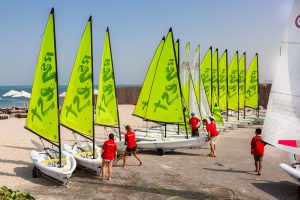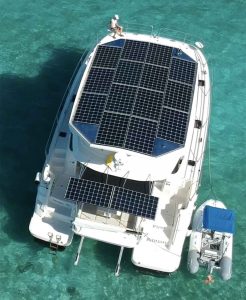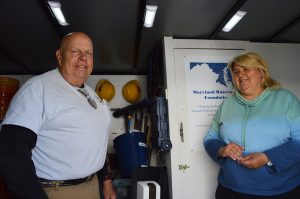
As I exited the pool, my wet feet left dark footprints on the deck. I watched the footprints fade under the mid-day sun and thought of the travel quote “Take only memories, leave only footprints.” No doubt, the temporal nature of such footprints is what Chief Seattle, a 19th century Native American chief, referred to when he coined the phrase in a speech about ecological responsibility. Today we know not all footprints are so fleeting, specifically our carbon footprint.
Naturally occurring gases, such as carbon dioxide and methane, are called greenhouse gases because they trap heat in our atmosphere. While this phenomenon is part of what makes earth habitable, excessive production due to human activity has been linked to global warming. Our carbon footprint refers to the amount of these gases produced by our actions. About three-quarters of greenhouse gas emissions are the result of burning fossil fuels.
For boaters, our two greatest carbon footprint contributors are engines and generators. Fuel guzzling powerboats, diesel-sipping trawlers and even less fuel dependent sailboats produce an impactful carbon footprint. In response, the marine industry is seeing exciting innovations, and boat owners are finding ways to reduce their carbon footprint with eco-friendly boats.
New Planet-Friendly Vessels
Eco-friendly boats that maximize clean energy alternatives are becoming increasingly more mainstream. Greenline Yachts and Silent Yachts are perfect examples eco-responsible boating innovations.

Since introducing the first hybrid boat in 2008, Greenline now offers eight different models, each capable of conventional, hybrid or electric drive. Their H-Drive system combines diesel modes with solar-electric options supported by high-capacity lithium battery banks. Owners can seamlessly switch between power sources to manage fuel consumption and emissions.
Fully solar-electric powered boats were once considered limited by size and cruising range. Silent Yachts has challenged that stereotype with its line of fully solar powered productions yachts.
In 2018, the Silent 64 crossed the Atlantic Ocean affirming that the solar-electric drivetrain they developed was effective, efficient and reliable for long-range cruising even under variable conditions. Unique hull designs allow efficient placement of multiple solar panels. Paired with the storage capacity of lithium-ion batteries, this system sufficiently powers on board appliances as well as propulsion. The electric drivetrain is over 60% more energy efficient than a combustion engine, significantly reducing the carbon footprint.
Custom-Designed to Suit your Dreams
One boat owner took a DIY approach to reducing his carbon footprint. After living aboard a sailing catamaran for two years, Peter Weil was ready to transition to the ease of a power catamaran. He quickly learned he was not a fan of the “loud, fast and smelly” options on the market.
When he learned that manufacturers of large power catamarans were not yet open to alternative power concepts, he set about proving it could be done. Aware of the great strides in electric propulsion in the marine industry, he began the process of creating First Edition, a solar-electric catamaran.

The first hurdle was to acquire a hull. He chose the Aquila 44. After attempting to purchase it without engines, he was forced to buy it as manufactured. He removed the new diesel engines, reselling them on eBay, and unnecessary fuel tanks. This opened up plenty of space for the new solar-electric system components.
First Edition uses Torqeedo’s Deep Blue Hybrid, a fully integrated propulsion and energy management system. Weil redesigned the hard top to accommodate a vast solar array and modified the hull length, adding over five feet to each transom and improving its performance.
Inclusion of BMW i3 lithium-ion batteries are one of Weil’s favorite aspects of First Edition’s transformation. The significant energy storage, consistent current and lasting charging capacity of these batteries means First Edition can stay unplugged longer, enjoy quiet anchorages, and run close to energy neutral.
Advancements in lithium battery technology are helping boaters reduce generator dependance in eco-friendly boats. Swapping over to lithium batteries for your house bank may be a costly endeavor up front, but the benefit has a comparable payout. These high-density batteries store more energy for longer periods of time and greatly reduce or eliminate the need for generator power.
We may not all be ready for complete fossil fuel-free boating but adding renewable resource systems can help reduce generator use and harmful emissions. Adding solar panels to eco-friendly boats continues to be a popular way of extending power supplies. New technology in both rigid and flexible panels make it easier to find efficient and affordable systems.
Wind generators are a popular addition to eco-friendly boats if you want to harness energy while at anchor or in port. In some cases, units can produce enough wattage to charge 800-amp hours of battery capacity. On the downside, power harnessing is less efficient when under way or in protected anchorages.
Which renewable resource system is best for you will depend on your needs, space constraints, cruising environment and expectations.
We can all work to reduce our carbon footprint as we spend time on the water with family and friends. Perhaps if Chief Seattle were alive today, he would amend his quote, “Take only memories, and be mindful of your footprints.”
Read our eco-friendly boating series here!





